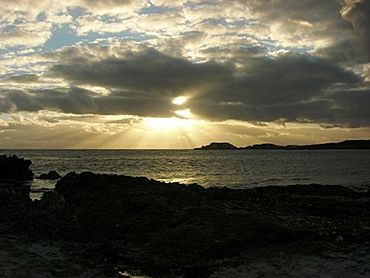Carpenter Rocks facts for kids
Quick facts for kids Carpenter RocksSouth Australia |
|||||||||||||||
|---|---|---|---|---|---|---|---|---|---|---|---|---|---|---|---|

Sunset over 'The Carpenter', from Gerloff Bay
|
|||||||||||||||
| Established | 31 October 1996 (locality) | ||||||||||||||
| Postcode(s) | 5291 | ||||||||||||||
| Time zone | ACST (UTC+9:30) | ||||||||||||||
| • Summer (DST) | ACDT (UTC+10:30) | ||||||||||||||
| Location |
|
||||||||||||||
| LGA(s) | District Council of Grant | ||||||||||||||
| Region | Limestone Coast | ||||||||||||||
| County | Grey | ||||||||||||||
| State electorate(s) | Mount Gambier | ||||||||||||||
| Federal Division(s) | Barker | ||||||||||||||
|
|||||||||||||||
|
|||||||||||||||
| Footnotes | Adjoining localities | ||||||||||||||
Carpenter Rocks is a small town and area in the south-east of South Australia. It is about 35 kilometers (22 miles) southwest of Mount Gambier. This coastal spot faces the Southern Ocean. It is famous for its rugged coastline, which is great for fishing and diving.
Carpenter Rocks is part of the District Council of Grant. It is also in the electoral district of Mount Gambier for state government. For federal government, it is in the Division of Barker.
Contents
History of Carpenter Rocks
Early People of the Area
The first people to live in the Carpenter Rocks area were Aboriginal communities. They belonged to the Booandik tribe. These groups lived in small camps along the coast. They found plenty of food and water there.
European Discovery
Lieutenant James Grant was the first known British person to see this land. He was on the ship HMS Lady Nelson in 1800. He saw what he thought were islands. Later, he realized they were mountains and capes. One of these capes, just west of the town, he named Cape Banks.
In 1802, French explorer Nicholas Baudin sailed by on his ship Geographe. He noticed the area and wrote about it. He described a long line of rocks along the beach. He said the waves crashed over them with great force. This created a constant loud noise.
How Carpenter Rocks Got Its Name
According to historians, Nicholas Baudin named "The Rocks" as "Les Carpentiers." This means "The Carpenters" in French. He thought the jagged and uneven shape of the rocks looked like a carpenter's saw.
The Admella Shipwreck
In 1859, a passenger ship called the Admella was wrecked. It hit a reef near Cape Banks, off the coast of Carpenter Rocks. The ship was traveling from Port Adelaide to Melbourne. Many lives were lost because rescue boats could not get close enough.
The Cape Banks Lighthouse is an important landmark. It is listed as a state heritage place. This means it is protected for its historical value.
Establishment of the Locality
On October 31, 1996, the boundaries for the Carpenter Rocks area were officially set. The area was given its "long established name."
Things to See and Do
Canunda National Park
Carpenter Rocks is a starting point for exploring the Canunda National Park. It is also close to Lake Bonney SE. These areas offer beautiful natural scenery.
Fishing and Boating
The town is important for the southern rock lobster industry. Many fishing boats are kept safely in Bucks Bay. This bay provides a calm place for them to dock.
Cape Banks Lighthouse
The Cape Banks Lighthouse is about 4 kilometers (2.5 miles) from the town. It stands near the spot where the Admella shipwreck happened in 1859.


